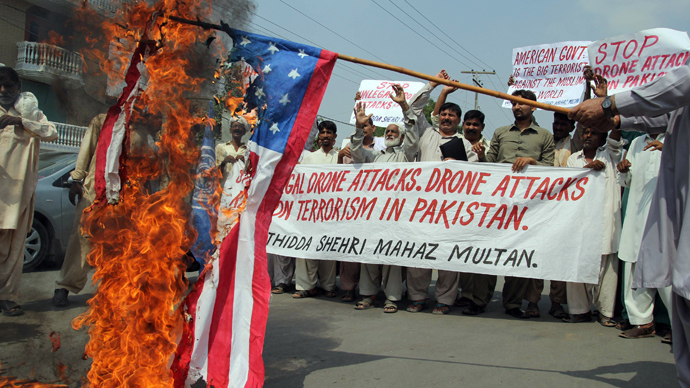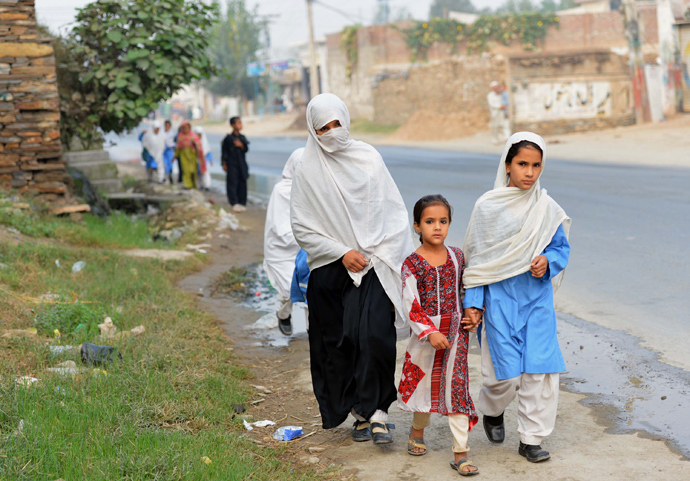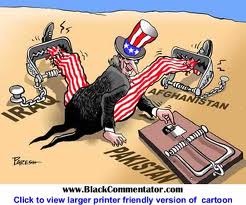Our Announcements
Sorry, but you are looking for something that isn't here.
Posted by admin in US DRONE WAR ON PAKISTAN on October 30th, 2013

Pakistani protesters belonging to United Citizen Action march behind a burning US flag during a protest in Multan on September 30, 2013, against the US drone attacks in Pakistani tribal areas (AFP Photo / S.S Mirza)
With the increased use of remotely piloted aircraft in military operations in a number of countries, the nagging question of civilian “collateral damage” as a consequence of these deadly technologies is a growing concern for the United Nations and human right groups.
In Afghanistan, for example, the number of aerial drone strikes surged from 294 in 2011 to 447 during the first 11 months of 2012, according to data released by the US Air Force in November 2012, UN Special Rapporteur Ben Emmerson noted in his interim report.
Pakistan officials confirmed that out of 2,200 deaths “at least 400 civilians had been killed as a result of remotely piloted aircraft strikes and a further 200 individuals were regarded as probable non-combatants.”
Although the first missile test-fired from a drone occurred in February 2001, it wasn’t until the end of 2012 that the UN Assistance Mission in Afghanistan (UNAMA) released data showing that 16 civilians had been killed and 5 injured due to drone strikes during the course of the year.
In its latest published figures, covering the first six months of 2013, UNAMA documented 15 civilian deaths and 7 injuries in seven separate attacks by drone aircraft.
Emmerson’s 24-page document, which is due to be presented to the UN General Assembly next Friday, mentions a report by a US military advisor that contradicted official US claims that drone attacks were responsible for fewer civilian deaths compared with other aerial platforms, for example, fighter jets.
He pointed to research by Larry Lewis, a research scientist at the Center for Naval Analyses, who examined aerial strikes in Afghanistan from mid-2010 to mid-2011. With the help of classified military data, Lewis found that the missile strikes conducted by drones were “10 times more deadly to Afghan civilians” than those performed by fighter jets, according to a report by The Guardian newspaper.

Northrop Grumman / Chad Slattery / Handout via Reuters
The United States and the United Kingdom have been reluctant to hand over information regarding drone strikes of any sort, including those that result in civilian deaths. For example, on February 21, 2010, 23 civilians were killed and 12 wounded in a Predator strike in southern Afghanistan’s Uruzgan province.
The US military released partially declassified information on the incident, suggesting “administrative and disciplinary sanctions” against the crew for providing misleading “situational information” as well as “a predisposition to engage in kinetic activity (the release of a missile).”
Emmerson said the US, which has attracted a lot of scorn in Afghanistan over the drone attacks, had created “an almost insurmountable obstacle to transparency.”
“The Special Rapporteur does not accept that considerations of national security justify withholding statistical and basic methodological data of this kind,” Emmerson wrote in the report.
The United Kingdom, which also figured into the report, has officially admitted to one civilian casualty incident, in which four civilians were killed and two civilians injured in a remotely piloted aircraft strike by the Royal Air Force in Afghanistan on March 25, 2011.
However, that figure remains open to speculation given that the United Kingdom’s ‘Reaper’ drone has flown more than 46,000 hours in Afghanistan, averaging three sorties per day, with a total of 405 weapons discharged.
Emmerson also reported that Pakistan’s Ministry of Foreign Affairs provided him with statistics on drone strikes in the Federally Administered Tribal Areas of Pakistan, where the US military has targeted members of Al-Qaeda since 2004.
The government noted the difficulties in determining the exact number of civilian deaths due to particular“topographical and institutional obstacles” of the Tribal Areas, including the tradition of immediately burying the bodies of the dead. So the figures are likely to be an underestimate.
The highest amount of civilian casualties, Emmerson noted, came when the CIA dramatically increased drone attacks in Pakistan between 2008 and 2010. Following intense criticism from Islamabad, however, drone strikes in Pakistan have steadily declined and “the number of civilian deaths has dropped dramatically.”

Pakistani schoolgirls walk along a path after school in Mingora, a town in Swat valley (AFP Photo / A Majeed)
In September, the Bureau of Investigative Journalism (TBIJ), a non-profit organization launched a project,“Naming the Dead,” to record properly the names and numbers of people who are killed by US drone airstrikes in Pakistan.
Civilian fatalities attributed to US drone strikes have occurred beyond the borders of Afghanistan and Pakistan, including in Yemen, where the figure is 12-58, according to Emmerson. Statistics are not yet available from Iraq or the Nato operation in Libya in 2011.
Meanwhile, with America’s arch-enemy Al-Qaeda looking increasingly fractured, especially with the death of its terror mastermind, Osama bin Laden, the question as to who now qualifies as a legitimate target of US strikes is becoming more pertinent. More importantly, perhaps, are the limitations that the United States and other countries must recognize as the battle against ‘terrorism’ goes global.
The International Committee of the Red Cross (ICRC) has noted the absence of a clear international consensus on the issue, Emmerson noted. But one thing that is generally accepted, however, is that“international humanitarian law does not permit the targeting of persons directly participating in hostilities who are located in non-belligerent States, given that, otherwise, the whole world is potentially a battlefield,” the report emphasized.
In Washington, the report got a lukewarm reception with White House spokesperson Laura Magnuson saying, “We are aware that this report has been released and are reviewing it carefully.”
She noted that at the National Defense University on May 23, “[T]he President spoke at length about the policy and legal rationale for how the United States takes action against Al-Qaeda and its associated forces. As the President emphasized, the use of lethal force, including from remotely piloted aircraft, commands the highest level of attention and care.”
The Special Rapporteur intends to submit a final report on the subject of robotic aircraft in counter-terrorism operations to the Human Rights Council in 2014.
Posted by Fawad Mir in Pakistan Security, Pakistan Security and Defence: Enemy & Threats (Internal & External), Pakistan-US Relations, US Interference in Balochistan on May 8th, 2013
By Beenish Ahmed, November 6, 2012
Outside a downtown Islamabad coffee shop that sells an assortment of French macaroons (cupcakes are so passé), I strike up a conversation with Omar Malik.
A 34-year-old who works for a private telecommunications company, Malik seems liberal. Liberal in the way Americans stumbling through Muslim-majority countries might find comforting.
 He’s dressed smartly in a collared shirt—with only the appropriate number of buttons unbuttoned. He sips a latte and speaks in flawless, albeit slightly accented, English.
He’s dressed smartly in a collared shirt—with only the appropriate number of buttons unbuttoned. He sips a latte and speaks in flawless, albeit slightly accented, English.
When it comes to American politics, though, he isn’t technically “liberal” —at least as far as U.S. political categories go.
“Republicans have historically always been better for Pakistan than Democrats,” Malik says matter-of-factly. “In terms of the relations that we have had, I think Bush was a much better president than Obama or Clinton was.”
He leans back in his lawn chair when I inquire further. This is not what I expected to hear from a man outside a posh cafe on a Saturday night, but he continues, “In terms of foreign policy, in terms of [not] giving preference to India over Pakistan, the Republicans have been much more balanced,” Malik says.
I remind him of how, when pressed during the presidential debate on foreign policy, Mitt Romney said he’d continue President Obama’s policy of using drones to target terrorist enclaves in Pakistan.
But Malik is resolute. He chalks Romney’s assertion up to campaign rhetoric. The sort of tough-on-terror talk, he says knowingly, that Obama also ran on four years ago.
Pakistan has long been seen by American analysts as a “wildcard” state—a sort of trick card that either appears as a Queen of Hearts or a Joker depending on when, and for how long, you look.
It’s a trick ordinary Pakistanis—who would probably just as readily fill the streets to protest America as they would to claim a visa if the United States decided to offer up them up for free—can play just as well. Nearly three-fourths of Pakistanis polled said they see the United States as an “enemy.” That’s up from 64 percent just three years ago.
As if to say “if you can’t beat ’em, join ’em,” another recent poll found that 43 percent of Pakistanis claimed they should have the right to vote in U.S. elections, a number topped only by people in Kenya, China, India, and Cameroon.
“Pakistanis should be given the right to vote,” says Rahat Khan, a 27-year-old who manages supply orders at a construction company in Islamabad. He adds completely earnestly, “After all, all of the decisions made about Pakistan are made in America.”
Khan even goes so far as to say that Pakistan should be made the “53rd state”—although he’ll likely have to brush up on his geography should he ever decide to actually apply for U.S. citizenship and cast a ballot in American elections.
If he could vote, Khan says, he’d cast a vote for Obama. But there’s one issue that he can’t get behind. “Being a patriotic Pakistani,” Khan insists, “I must say that drone attacks should be stopped.”
Like many Pakistanis, Khan sees the use of drones as an affront to his country’s sovereignty. The continuing attacks on sites the United States identifies as terrorist enclaves in the tribal areas are approved by only a small number of elite Pakistanis. He says the unmanned assaults kill more innocent people than the terrorists they target.
The vitriolic issue of drone strikes is compounded by a number of other incidents that have stoked Pakistani anger at America.
In January 2011, CIA contractor Raymond Davis shot and killed two Pakistani men in the city of Lahore. To make matters worse, a car coming to aid Davis from the U.S. consulate killed a man in the street before speeding off down the wrong side of the road. Although “blood money” was paid to the victims’ families, the incident spurred a public outcry over the evident impunity for Americans who had committed murder.
Then, last November, a U.S. attack on a military outpost near the Afghanistan border killed 24 Pakistani soldiers, leading Pakistan to close NATO supply routes into Afghanistan. The passages remained closed for months.
And of course there was the unannounced raid in which U.S. Navy SEALS killed Osama bin Laden four months ago, which Pakistanis largely believe to be either offensive or fictitious.
Add up these incidents—along with the anger over the hokey film trailer defaming the Prophet Mohammad that inflamed the rest of the Islamic world—and it’s easy to come up with Obama’s incredibly low approval rating in Pakistan. Still, it is surprising that Pakistanis would see Obama on par with former President George W. Bush, whom many across the world still disapprove of for starting two wars on feeble foundations.
The poll, which was conducted by the Pew Global Attitudes Project, found that Pakistan was the only country of the 15 polled where ratings for Obama were no better than those maintained by former President George W. Bush.
Thirteen percent of Pakistanis polled said they would vote for Obama if they could, over a mere 9 percent who say they would support Romney. But the more telling statistic might be the 47 percent who believe that neither candidate would change U.S. policy.
Beenish Ahmed, “Pakistan: The Real Swing State” (Washington, DC: Foreign Policy In Focus, November 6, 2012)